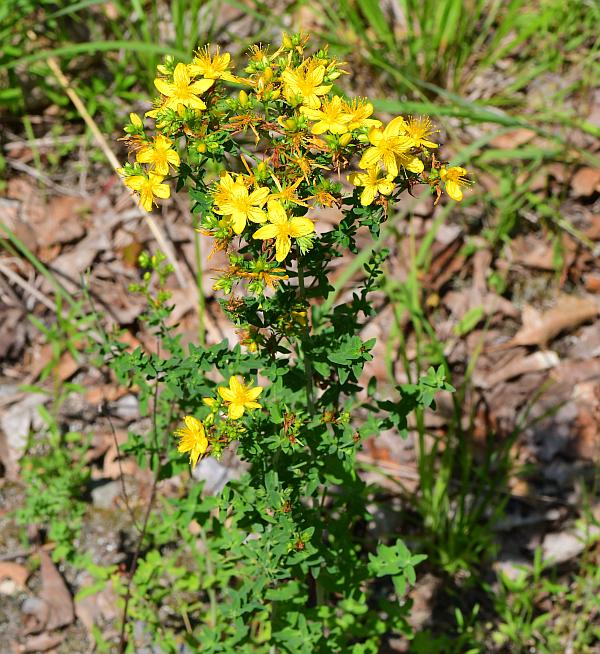Hypericum perforatum L.
Common St. John's-Wort

Introduced
CC = *
CW = 3
MOC = 77
© SRTurner
Hypericum perforatum L.Common St. John's-Wort | |
 |
Introduced CC = * CW = 3 MOC = 77 |
© SRTurner |
|
Family - Hypericaceae Habit - Perennial forb, the rootstock and stem bases often somewhat woody, often with short to long rhizomes.
Stems - Ascending to erect, to 75 cm, sometimes multiple from base, the upper portion sharply ridged below each leaf, green to reddish brown, the surface often peeling in thin strips with age, glabrous.
Leaves - Opposite, decussate, simple, sessile. Blades 4-20 mm long, 2-8 mm wide, linear to narrowly oblong-elliptic, rounded to bluntly pointed or occasionally shallowly notched at the tip, narrowed or rounded at the base, the margins flat or somewhat rolled under at maturity, herbaceous in texture, with 1 or less commonly 3 main veins usually visible toward the base, the surfaces with few to many variously noticeable or inconspicuous yellowish brown to dark green or black dots or less commonly lines, or streaks, also with numerous pellucid dots, the upper surface green, the undersurface paler but only rarely slightly glaucous.
Inflorescences - Appearing as panicles of 30-200 flowers, rounded to more or less flat-topped in outline. Pedicels 0 to 2 mm long, glabrous.
Flowers - Actinomorphic. Sepals 5, all more or less similar in size and shape, 3-6 mm long, narrowly lanceolate, the margins flat, with usually few noticeable black dots or streaks, these sometimes difficult to observe in fruiting material. Petals 5, 7-12 mm long, oblanceolate to obovate or elliptic, bright yellow, with yellowish brown or black dots present but usually relatively few and restricted to at or near the margins, withered and inconspicuous but usually persistent at fruiting. Stamens 45-85, the filaments fused into 3 groups toward the base. Ovary completely 3-locular (sometimes incompletely so at the very tip), the placentation axile. Styles 3, free above the base, more or less spreading, persistent, the stigmas capitate.
Fruits - Capsules 3.5-7.0 mm long, ovoid, widest below the midpoint, tapered to the minute beaks, bluntly triangular to more or less circular in cross-section. Seeds numerous, 0.9-1.2 mm long, the surface with a coarse network of ridges and pits, dark brown to black.
Flowering - May - September. Habitat - Glades, upland prairies, forest margins, fields, pastures, levees, ditches, roadsides, railroads, open disturbed areas. Origin - Native to Europe. Lookalikes - H. punctatum. Other info. - This species of St. John's wort is found throughout Missouri, as well as much of the eastern and western regions of the continental U.S. Plants in this genus are generally recognized by their opposite leaves having numerous translucent ("pellucid") dots, these being easily observed by holding a leaf up to a bright light source. This species is differentiated from others in the genus by having black dots along the margins of the petals (and not in the interior of the petals). Photographs taken in Pictured Rocks National Seashore, MI., 7-22-02 (DETenaglia); also at Klondike County Park, St. Charles County, MO, 7-5-2013, in Spokane, Spokane County, WA, 6-13-2015, and near Loda Lake, Newaygo County, MI, 7-5-2023 (SRTurner). |